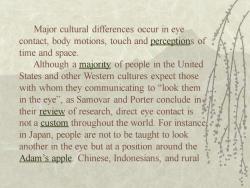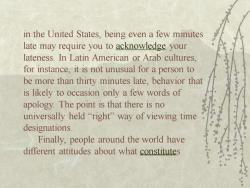吉林大学:《商务英语选读》课程电子教案(PPT课件)Unit 7 Text c Cultural Differences

Text C Cultural Differences
Text C Cultural Differences

Warm-up Have you ever noticed body language in different cultures? How do people in different cultures perceive eye contact? How do Americans show "OK"by their gesture? In what areas do usually cultural differences occur according to the passage? Could you tell some differences in different cultures? In your opinion,how could people overcome these differences?
Warm-up ❖ Have you ever noticed body language in different cultures? ❖ How do people in different cultures perceive eye contact? ❖ How do Americans show “OK” by their gesture? ❖ In what areas do usually cultural differences occur according to the passage? ❖ Could you tell some differences in different cultures? ❖ In your opinion, how could people overcome these differences?

outline Major cultural differences occur in eye contact; body motions,touch and perceptions of time and space. Different use of eye contact Different use of gestures,movements,and facial expressions Different use of touching behavior Different perceptions of time Appropriate distances for various interactions
outline ❖ Major cultural differences occur in eye contact, body motions, touch and perceptions of time and space. ❖ Different use of eye contact ❖ Different use of gestures, movements, and facial expressions ❖ Different use of touching behavior ❖ Different perceptions of time ❖ Appropriate distances for various interactions

Major cultural differences occur in eye contact,body motions,touch and perceptions of time and space. Although a majority of people in the United States and other Western cultures expect those with whom they communicating to"look them in the eye",as Samovar and Porter conclude in their review of research,direct eye contact is not a custom throughout the world.For instance in Japan,people are not to be taught to look another in the eye but at a position around the Adam's apple.Chinese,Indonesians,and rural
Major cultural differences occur in eye contact, body motions, touch and perceptions of time and space. Although a majority of people in the United States and other Western cultures expect those with whom they communicating to “look them in the eye”, as Samovar and Porter conclude in their review of research, direct eye contact is not a custom throughout the world. For instance, in Japan, people are not to be taught to look another in the eye but at a position around the Adam’s apple. Chinese, Indonesians, and rural

Mexicans also lower their eyes as a sign of defense -to them too much eye contact is a sign of bad manners.Arabs,in contrast,look directly into the eyes of the person with whom they are talking for long periods -to them direct eye contact shows interest.There are also differences in use of eye contact in the subcultures of the United States.For instance,blacks use more continuous eye contact than whites when they are speaking but less when they are listening
Mexicans also lower their eyes as a sign of defense - to them too much eye contact is a sign of bad manners. Arabs, in contrast, look directly into the eyes of the person with whom they are talking for long periods - to them direct eye contact shows interest. There are also differences in use of eye contact in the subcultures of the United States. For instance, blacks use more continuous eye contact than whites when they are speaking but less when they are listening

People of other cultures also show considerable differences in use of gestures, movements,and facial expressions.Gestures in particular can assume completely different meanings.For instance,the forming of circle with the thumb and forefinger,the OK sign in. the United States,means zero or worthless in France,a symbol for money in Japan,a curse in some Arab countries,and an obscene gesture in Germany,Brazil,and Australia.In addition,displays of emotion also vary.For
People of other cultures also show considerable differences in use of gestures, movements, and facial expressions. Gestures in particular can assume completely different meanings. For instance, the forming of circle with the thumb and forefinger, the OK sign in the United States, means zero or worthless in France, a symbol for money in Japan, a curse in some Arab countries, and an obscene gesture in Germany, Brazil, and Australia. In addition, displays of emotion also vary. For

instance,in some Eastern cultures,people have been socialized to identify emotional behavior cues,whereas members of other culture have been socialized to amplify their displays which are often reflected in the interpretation that can be given to facial expressions. Differences in touching behavior are, according to Gudykunst and Kim,highly correlated with culture."People in high contact cultures evaluate 'close'as positive and good, and evaluate far'as negative and bad.People
instance, in some Eastern cultures, people have been socialized to identify emotional behavior cues, whereas members of other culture have been socialized to amplify their displays which are often reflected in the interpretation that can be given to facial expressions. Differences in touching behavior are, according to Gudykunst and Kim, highly correlated with culture. “People in high contact cultures evaluate ‘close’ as positive and good, and evaluate ‘far’ as negative and bad. People

in low contact cultures evaluate 'close'as negative and bad,and far'as positive and good"Specifically,Latin America and the Mediterranean countries are high contact, the United States is moderate contact,and the Far East is low contact. A particular important area of differences concerns perception of time.In the United States we compartmentalize our time and schedules one event at a time which is exemplified by our tendency to emphasize schedules and value promptness.As a result
in low contact cultures evaluate ‘close’ as negative and bad, and ‘far’ as positive and good” Specifically, Latin America and the Mediterranean countries are high contact, the United States is moderate contact, and the Far East is low contact. A particular important area of differences concerns perception of time. In the United States we compartmentalize our time and schedules one event at a time which is exemplified by our tendency to emphasize schedules and value promptness. As a result

in the United States,being even a few minutes late may require you to acknowledge your lateness.In Latin American or Arab cultures, for instance,it is not unusual for a person to be more than thirty minutes late,behavior that is likely to occasion only a few words of apology.The point is that there is no universally held"right"way of viewing time designations. Finally,people around the world have different attitudes about what constitutes
in the United States, being even a few minutes late may require you to acknowledge your lateness. In Latin American or Arab cultures, for instance, it is not unusual for a person to be more than thirty minutes late, behavior that is likely to occasion only a few words of apology. The point is that there is no universally held “right” way of viewing time designations. Finally, people around the world have different attitudes about what constitutes

appropriate distances for various interactions. White people in the United States typically consider the space of up to a foot or eighteen inches from their bodies as personal or intimate space,and they do not expect people to violate that space.In Middle East,however men seek to move much closer to other men when they are taking.Thus,when an Arab man talks with a white person form the United States,one of the two is likely to be uncomfortable
appropriate distances for various interactions. White people in the United States typically consider the space of up to a foot or eighteen inches from their bodies as personal or intimate space, and they do not expect people to violate that space. In Middle East, however, men seek to move much closer to other men when they are taking. Thus, when an Arab man talks with a white person form the United States, one of the two is likely to be uncomfortable
按次数下载不扣除下载券;
注册用户24小时内重复下载只扣除一次;
顺序:VIP每日次数-->可用次数-->下载券;
- 吉林大学:《商务英语选读》课程电子教案(PPT课件)Unit 7 Text b Written Communication.ppt
- 吉林大学:《商务英语选读》课程电子教案(PPT课件)Unit 7 Text a Barrier to International communication.ppt
- 吉林大学:《商务英语选读》课程电子教案(PPT课件)Unit 6 Text c Culture and Communication.ppt
- 吉林大学:《商务英语选读》课程电子教案(PPT课件)Unit 6 Text b Business Communication.ppt
- 吉林大学:《商务英语选读》课程电子教案(PPT课件)Unit 6 Text a How to Understand Body Language.ppt
- 吉林大学:《商务英语选读》课程电子教案(PPT课件)Unit 5 Text c Good Body Language Is Part of Good Communication.ppt
- 吉林大学:《商务英语选读》课程电子教案(PPT课件)Unit 5 Text b Nonverbal Communication.ppt
- 吉林大学:《商务英语选读》课程电子教案(PPT课件)Unit 5 Text a Oral Presentation.ppt
- 吉林大学:《商务英语选读》课程电子教案(PPT课件)Unit 4 Text c How to Argue.ppt
- 吉林大学:《商务英语选读》课程电子教案(PPT课件)Unit 4 Text b Sharpening Your Basic Skills.ppt
- 吉林大学:《商务英语选读》课程电子教案(PPT课件)Unit 4 Text a Suggestions for Effective Listening.ppt
- 吉林大学:《商务英语选读》课程电子教案(PPT课件)Unit 3 Text c The Importance of Listening.ppt
- 吉林大学:《商务英语选读》课程电子教案(PPT课件)Unit 3 Text b How Can You Develop Effective Communication Skills?.ppt
- 吉林大学:《商务英语选读》课程电子教案(PPT课件)Unit 3 Text a Functions of On-the-job Communication.ppt
- 吉林大学:《商务英语选读》课程电子教案(PPT课件)Unit 2 Text c Levels of Communication.ppt
- 吉林大学:《商务英语选读》课程电子教案(PPT课件)Unit 2 Text b How to Start a Conversation in Britain.ppt
- 吉林大学:《商务英语选读》课程电子教案(PPT课件)Unit 2 Text a How to Be Entertained.ppt
- 吉林大学:《商务英语选读》课程电子教案(PPT课件)Unit 1 Text c Gift Giving.ppt
- 吉林大学:《商务英语选读》课程电子教案(PPT课件)Unit 1 Text b Handshake.ppt
- 吉林大学:《商务英语选读》课程电子教案(PPT课件)Unit 1 Text a Etiquette and Protocol in Business(主讲人:景超).ppt
- 吉林大学:《商务英语选读》课程电子教案(PPT课件)Unit 8 Text a Guides to Good Intercultural Communication.ppt
- 吉林大学:《商务英语选读》课程电子教案(PPT课件)Unit 8 Text b Case Study - Communication Skills.ppt
- 吉林大学:《商务英语选读》课程电子教案(PPT课件)Unit 8 Text c Case Study - Oral Communication.ppt
- 吉林大学:《大学英语泛读》课程PPT教学课件(book 3)Unit 1 Reading for A’s.ppt
- 吉林大学:《大学英语泛读》课程PPT教学课件(book 3)Unit 2 Why Not Speed Up Your Reading?.ppt
- 吉林大学:《大学英语泛读》课程PPT教学课件(book 3)Unit 3 Romantic Roundabout.ppt
- 吉林大学:《大学英语泛读》课程PPT教学课件(book 3)Unit 4 The Lucky Archaeologist.ppt
- 吉林大学:《大学英语泛读》课程PPT教学课件(book 3)Unit 5 News of the Engagement.ppt
- 吉林大学:《大学英语泛读》课程PPT教学课件(book 3)Unit 6 The Story of Jazz.ppt
- 吉林大学:《大学英语泛读》课程PPT教学课件(book 3)Unit 7 The Experiences of a Chinese Immigrant, 1880-1903.ppt
- 吉林大学:《大学英语泛读》课程PPT教学课件(book 3)Unit 8 How to Guess Your Age.ppt
- 吉林大学:《大学英语泛读》课程PPT教学课件(book 3)Unit 9 The Sixth Sense.ppt
- 吉林大学:《大学英语泛读》课程PPT教学课件(book 3)Unit 10 Long Walk to Forever.ppt
- 吉林大学:《大学英语泛读》课程PPT教学课件(book 3)Unit 11 Father and Son.ppt
- 吉林大学:《大学英语泛读》课程PPT教学课件(book 3)Unit 13 I Thought About This Girl.ppt
- 吉林大学:《大学英语泛读》课程PPT教学课件(book 3)Unit 14 The Gift of understanding.ppt
- 吉林大学:《大学英语泛读》课程PPT教学课件(book 3)Unit 15 A Horrible Experience.ppt
- 吉林大学:《大学英语泛读》课程PPT教学课件(book 3)Unit 16 Exercise and Health(一).ppt
- 吉林大学:《大学英语泛读》课程PPT教学课件(book 3)Unit 17 Exercise and Health(二).ppt
- 吉林大学:《大学英语泛读》课程PPT教学课件(book 3)Unit 18 My Sixth Christmas.ppt
